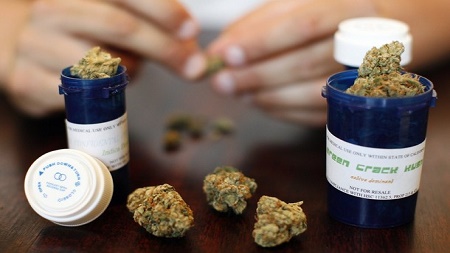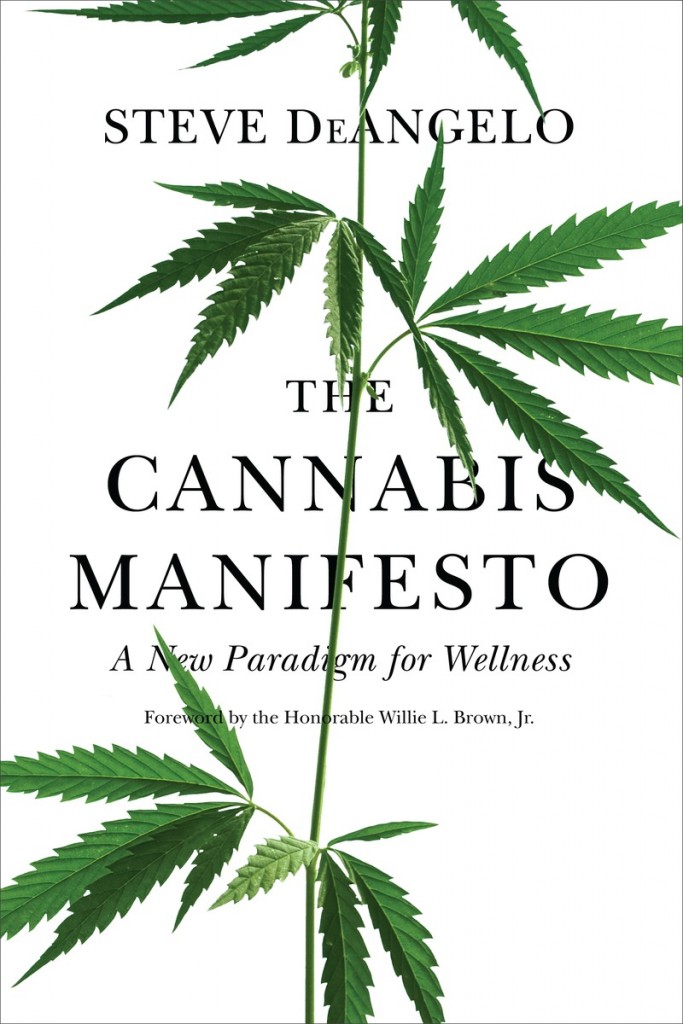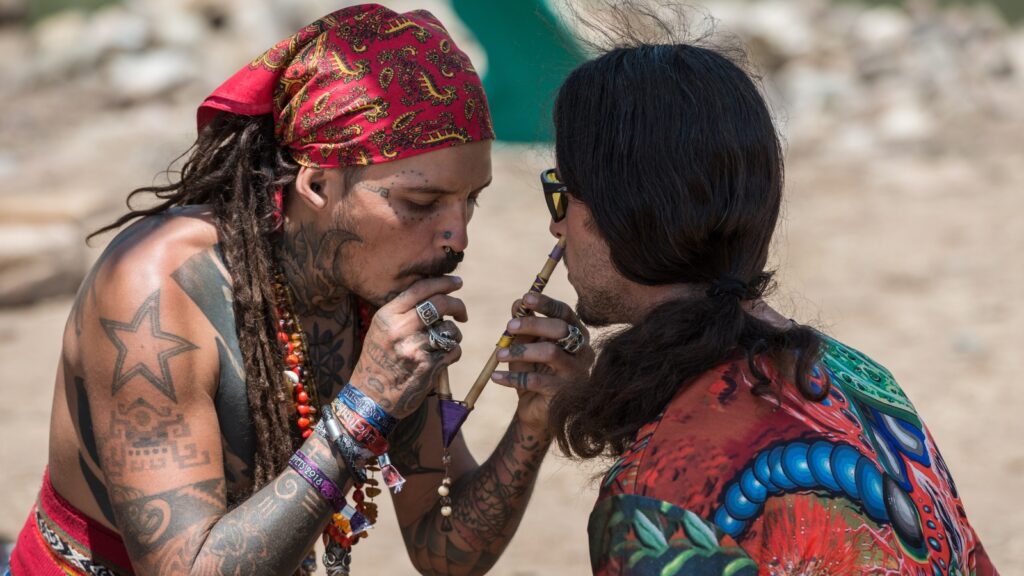The following cannabis piece is excerpted from The Cannabis Manifesto: A New Paradigm for Wellness by Steve DeAngelo, published by North Atlantic Books.
I’ll never forget the first time Jason David showed me a home video of his then five-year-old son, Jayden. A pale young boy with slender build and delicate features was curled into a fetal position, eyes wide with fear and bewilderment, limbs and torso and head uncontrollably convulsing in the midst of a grand mal seizure. With tears in his eyes, Jason explained that Jayden suffered from Dravet’s Syndrome, the most severe and life-threatening form of childhood epilepsy.
This fragile boy was on twenty-one prescription medicines and had taken more than 25,000 pills since he was born, but he still suffered multiple grand mal seizures every day. The pharmaceuticals failed to control Dravet’s Syndrome, but they did put Jayden into a zombie-like condition, unable to learn or develop.
Jason came to Harborside—the Oakland cannabis dispensary I co-founded in 2006—at his wit’s end, terrified by both the seizures and the devastating side effects of the drugs prescribed by doctors. He had seen a news report about an epileptic girl arrested for possessing cannabis that she used to treat her condition. It was Jason’s first inkling that cannabis might be effective for Dravet’s.
Cannabis is one of the most investigated therapeutic substances in history. More than 20,000 studies and reviews regarding cannabis have been published in scientific literature, and the vast majority prove that its active ingredients are uniquely safe and effective. Side effects are relatively mild and short-acting, and there is no lethal dose. You could theoretically die of carbon-monoxide poisoning if you inhaled enough smoke, but nobody has ever died from ingesting too much cannabis.
We supplied Jason with a child-friendly, alcohol-free tincture designed to alleviate seizures without causing euphoria. He called us the next day. The tincture had been immediately and profoundly effective— Jayden had not had a single seizure since. We asked Jason to keep us posted.
A couple weeks later, he came back to Harborside with a second home video. Jayden was smiling, alert, and present, playing with a toy truck. The little boy hummed a tune, clambered over his Dad, and goofed for the camera—clearly a much happier child. The frequency and severity of Jayden’s seizures dropped by 90 percent. He had gained weight, was calmer and more focused, and was playing and communicating in ways not previously possible.
What keeps me up at night is not the fear of federal raids or prosecution, or the multiple death sentences I am technically eligible for. What keeps me up is worrying about the millions of patients like Jayden around the world. They and their families suffer horribly from devastating illnesses for which Western medicine has no cure, and often no palliative relief. They are patients whom I know Harborside could help, just like we helped Jason and Jayden—if only the laws would allow us to.
Cannabis has always been a medicine, probably used by human beings since before the dawn of civilization. For the hundreds of thousands of years prior to the invention of modern chemistry, plants were all we had in the way of medicine. Some, like poppy and ephedra, are still used to produce pharmaceuticals today.
Cannabis is listed in the oldest known Chinese pharmacopeia, the Shennong Bencaojing, which is believed to be based on earlier texts as much as five thousand years old. Later Chinese medical texts recognize cannabis as one of fifty “fundamental” herbs and recommend the use of every part of the plant for one hundred twenty different conditions. The man considered the father of Chinese medicine, Shennong, is said by legend to have discovered the healing properties of cannabis, along with those of ginseng and ephedra.
Cannabis was also a part of ancient Egyptian medicine. Across many centuries, Egyptian medical papyri included instructions for the administration of cannabis. It was recommended for ophthalmological, obstetric, digestive, and urological disorders, for glaucoma and premenstrual syndrome—and most notably to “paralyze” tumors.
Other ancient cultures that used cannabis as medicine include the Assyrians, Greeks, Hindus, and Jews. It was recommended for a vast number of conditions, including impotence, neuralgia, epilepsy, kidney stones, pulmonary congestion, spasticity, depression, anxiety, insomnia, pain, digestion and appetite issues, and obstetric conditions.
Modern science has already confirmed the efficacy of cannabis for most uses described in the ancient medical texts, but prohibitionists still claim that medical cannabis is “just a ruse.” No medicine, they cry, can possibly do all those things.
When cannabis was first made illegal, it was impossible to understand the specifics of why it is effective for such a wide range of conditions. It wasn’t until the 1960s that inventions like gas chromatography enabled an Israeli scientist named Raphael Mechoulam to first isolate the active ingredients in cannabis.
It turns out cannabis is packed with therapeutic substances known as cannabinoids. Thus far researchers have identified eighty-five different ones, and suspect there are more. Each cannabinoid individually produces a distinct action in the human body, while different combinations and ratios of cannabinoids produce yet another range of distinct actions. Scientists refer to this as the entourage effect.
The only way to test the imported cannabis of my youth was rolling it up and smoking it, and seeing if it was strong or weak. Eventually we recognized that different batches of cannabis had subtly different effects— but we had no way of determining why, or selecting the effects we most desired. At Harborside today, every product is laboratory tested and labeled with the percentages of the major cannabinoids it contains. That enables our staff to guide patients to products with the best cannabinoid profile for their needs.
THC is the best known of the cannabinoids and is notorious for its psychoactive effects. It is powerfully effective for many conditions including insomnia, chronic pain, cancer, PTSD, glaucoma, low libido, and much more. The impact it has on the human mind is often its most therapeutic contribution.
By contrast, CBD—cannabidiol—is generally considered nonpsychoactive. It suppresses or balances the psychoactivity of THC and is the primary ingredient in the tincture responsible for Jayden David’s remarkable recovery—and that of thousands of other epilepsy patients.
CBD is an extraordinarily potent anti-inflammatory, anti-spasmotic, and neuroprotective substance. It dramatically reduces anxiety without affecting mental processes—so much so that in 2013 one city in the Netherlands distributed CBD-rich cannabis to eighty residents with chronic psychotic disorders. It has also been found effective for rheumatoid arthritis, diabetes, alcoholism, PTSD, antibiotic-resistant infections, and neurological disorders.
My father was not too worried about my teen smoking of cannabis in and of itself, but breaking the law was a big deal for him. It wasn’t until Harborside was licensed that we were really able to talk about cannabis comfortably. Today, at eighty-three, he uses three different formulations of cannabis tincture: CBD-rich, THC-rich, and a 50/50 blend.
Cannabis grows on every continent except Antarctica, and it has been found in some of the most ancient archeological sites. Folk healers around the world used it for a wide range of conditions long before formal systems of medicine were codified, and still do in places where poverty and geographic isolation make formal health care inaccessible. That is no doubt one of the reasons that Mexican immigrants fleeing the revolution made sure to bring cannabis with them.
Modern studies have validated many of these practices, finding “good scientific rationale for its historic reputation as a headache remedy and painkiller,” and that it is an effective antibiotic for a variety of microbes. These studies include the very first gold-standard, double-blind, and placebo-controlled human study of cannabis ever conducted in the United States.
Technological progress has led to a better understanding of the human body itself. In 1992, scientists made a startling discovery: the compounds in marijuana create their effects by stimulating a previously unknown cellular communication network. This electrochemical signaling system is known as the endocannabinoid system, and it regulates a vast number of critical processes in human physiology. These include the central nervous system, the autonomic nervous system, the endocrine network, the immune system, the gastrointestinal tract, the reproductive system, and microcirculation.
Remarkably, our own bodies endogenously produce endocannabinoids similar to THC and CBD. They can be found in the brain, organs, connective tissues, glands, and immune cells. Elevated levels of endocannabinoids are naturally present in human breast milk, and they are the source of the runner’s high. No matter where they are located in the body, the goal of endocannabinoids remains the same: homeostasis, or the maintenance of a stable internal environment despite fluctuations in the external environment.
Nobody even knew the endocannabinoid system existed twenty years ago, but today researchers believe it has been an integral part of the evolution of brains and nervous systems—because it is part of the physiology of all creatures except insects.
In a rational world, the discovery of the endocannabinoid system would have immediately ended all debate about whether cannabis is a medicine; but the federal policy of classifying cannabis as a drug with high abuse potential and no therapeutic use prevents medical schools from even offering courses in cannabis medicine. Dr. Donald Abrams, Chief Oncologist for the UCSF Research Hospital and author of the gold-standard pain study, reports that most doctors aren’t even aware of the existence of the endocannabinoid system, which researchers now believe is the largest neurotransmitter system in the human body.
The same federally mandated ignorance deters and distorts scientific research about cannabis, most of which is funded and authorized by one agency—the National Institute on Drug Abuse. NIDA has refused to fund research into the medical benefits of cannabis, claiming its charter prevents it from spending money on anything but the harms of drug use. Even worse, the agency suppressed promising leads about the therapeutic potential of cannabis for extremely grave diseases like cancer.
In 1975, the National Cancer Institute reported that THC inhibits the growth of lung-cancer tumors, and that bone marrow treated with cannabinoids showed a dose-dependent resistance to cancer.
NIDA ignored this promising lead and instead funded a study by the National Toxicology Project intended to prove that cannabis causes cancer. But the agency buried the study after researchers found that THC actually reduces cancer of the breasts, uterus, pancreas, and testicles. The only reason the findings ever came to light is because they were leaked to Dr. Abrams.
Incredibly, despite the prior evidence, NIDA continued trying to prove that cannabis causes cancer rather than investigating its alreadydemonstrated ability to fight the disease. In 2006, the agency commissioned Dr. Donald Tashkin to conduct a study intended to show that cannabis causes lung cancer, but he, too, found that it actually fights the disease.
Tashkin’s findings were confirmed by Harvard scientists in 2007, who found that THC could shrink cancerous tumors to half their size and slow the progress of the disease. The findings led Tashkin to reverse his previous opposition and endorse the legalization of cannabis, but they had no apparent effect on NIDA policy.
Almost every treatment currently offered to cancer patients is terrifying. Traditional chemotherapy targets all cells that divide rapidly. Some are cancerous and others are healthy, but chemo kills all of them. That’s what causes side effects like nausea, anorexia, hair loss, diarrhea, fever, and chills—and long-term consequences including organ damage, infertility, and cognitive impairment. Radiation has similar short- and long-term side effects, and it can lead to secondary cancer. Both are often just preludes to surgery.
The way cannabis fights cancer is more elegant, and seems almost magical. The essence of the disease is uncontrolled cell growth—and THC, CBD, and other cannabinoids trigger the death of cancer cells with a simultaneous two-front assault. The advance guard directly attacks the tumor by activating the receptors of the endocannabinoid system to induce apoptosis, the natural process of cell death, which is interrupted by cancer. Meanwhile, the outlying troops block angiogenesis, the process by which tumors acquire the blood vessels they need to continue growing. The tumors disintegrate from within, while being deprived of the blood they need to propagate further— without any damage to healthy tissue or horrifying side effects. And the higher the dose of cannabis, the more effective it appears to be. But that’s not all.
Cannabis also prevents the development of cancer in the first place, and inhibits its spread. THC and other cannabinoids have been found to prevent the reproduction, migration, and invasion of several types of cancer cells, including breast cancer, cervical cancer, oral cancer, neck cancer, head cancer, and bile-duct cancer. It appears to accomplish this feat primarily by blocking replication of cancer- causing viruses, like the gammaherpesvirus. The potent antiinflammatory
properties of cannabis may also help prevent cancer by maintaining healthy cell growth, DNA growth, and other physiological processes.
Some of the most common and deadly cancers respond well to cannabis. NIDA’s own researchers have repeatedly found it effective for lung cancer—the leading cause of cancer deaths in men and women. It is effective for prostate cancer, the most common form of cancer—and the second most frequent cause of cancer death—in American men. An abundance of evidence shows that cannabis also is effective for breast cancer, the most commonly diagnosed cancer among American women. And yet more research has established the efficacy of cannabis for colon and pancreatic cancer, also among the top ten cancer killers of women.
These studies are not flukes or fabrications. They are too many and too consistent to be wrong, and come from respected institutions like the University of Madrid, the British Journal of Cancer, the University of California San Diego, the University of South Florida, and the National Cancer Institute. All the evidence points in the same direction: cannabis can prevent and shrink tumors, and quite possibly eliminate them entirely—even with the worst types of cancer.
If any other substance showed the same results, hundreds of millions of dollars in public funding would be devoted to developing it. It is beyond reason that our tax dollars have for decades been poured into proving impossible myths about cannabis instead of exploring the most promising treatment for cancer ever discovered. Incalculable suffering and death have resulted, and it was entirely preventable. The therapeutic and curative potential of cannabis for cancer and other grave illnesses was well established by the middle of the nineteenth century, but its prohibition in the United States brought research to a standstill for most of the twentieth century. We’ll never know how many lives could have been saved if our elected officials had taken the medical potential of cannabis seriously instead of pandering to racism and ignorance.
Cannabis was introduced to Western medicine by Dr. William O’Shaughnessy, a physician for the British East India Company who lived in Calcutta, India, in the early 1830s.
O’Shaughnessy learned of Ayurvedic and folk-medicine uses of cannabis, and conducted years of experiments to validate its efficacy. What he learned amazed him—cannabis is indeed effective for rheumatoid arthritis, spasticity, pain, and many other conditions. O’Shaughnessy returned to England with a large stock of cannabis extract and provided it to physicians across the UK as Squire’s Extract.
O’Shaughnessy’s remarkable discovery rippled through English medicine, as other physicians found cannabis effective for a wide range of disorders. These included migraines, neuropathic pain, and Parkinson’s disease. The Queen’s personal physician called cannabis “by far the most useful of drugs for painful maladies,” and in 1890 Sir John Reynolds published an article in the iconic medical journal The Lancet recommending cannabis for what we now call Alzheimer’s disease.
At first, my stepmother Ginny just misplaced things, and nobody put it together for a while. Then it became difficult for her to answer simple questions, and Dad took her to the doctor. I’d never imagined my tough, hard-charging father as a caregiver, but as Ginny lost her memory, Dad picked up the slack. By the end, he was tenderly feeding her by hand, transferring her from bed to wheelchair to toilet, and brushing her hair every morning. He would sit holding Ginny’s hand for hours, listening to her rattling off increasingly inane stories, desperate to see some small spark of recognition in her eyes.
Next to cancer, Alzheimer’s may be the most feared disease in the developed world. The plaques and tangles it deposits in the brain disrupt the signals between neurons, and the perception of time and recollection of basic knowledge become difficult or impossible. Memories eventually disappear entirely. Patients become unable to recognize loved ones, and sometimes they turn angry and violent. Most patients die from infections as they forget how to urinate, defecate, swallow, and chew—sometimes lying in their own waste.
The disease is growing to epidemic proportions. At least 44 million people worldwide have been diagnosed with Alzheimer’s, and that number is expected to almost double by 2030. It will double again by 2050 if nothing is done to stop it. Alzheimer’s is the sixth leading cause of death in the United States, and regular cannabis use may be the best way to prevent the disease.
Researchers at the world-renowned Scripps Research Institute announced this important medical breakthrough in 2006, reporting that THC “possesses remarkable inhibitory qualities” for the plaques common to Alzheimer’s, and its effects are obtained via a “previously unrecognized molecular mechanism.” Subsequent studies supported the Scripps research and found that the mechanism works by providing neural protection and reducing inflammation. In another wonderful example of the elegance of cannabis biochemistry, the British Journal of Pharmacology reported that cannabinoids simultaneously support “the brain’s intrinsic repair mechanism and … the growth of new brain cells.”
I wish we’d known all that in time to save my stepmother.
* * *
From The Cannabis Manifesto: A New Paradigm for Wellness by Steve DeAngelo, published by North Atlantic Books, copyright © 2015 by Steve DeAngelo. Reprinted by permission of publisher.
Top photo by Abd allah Foteih, courtesy of Creative Commons Licensing.










